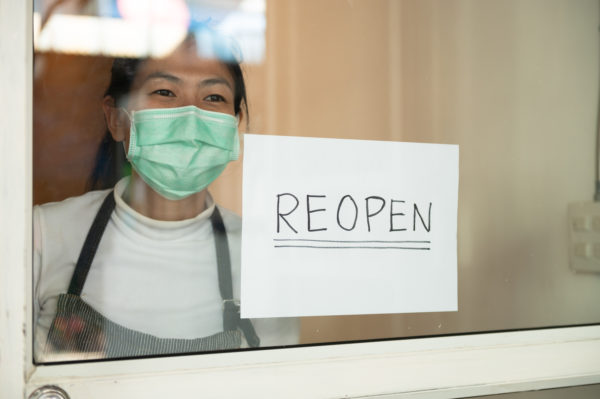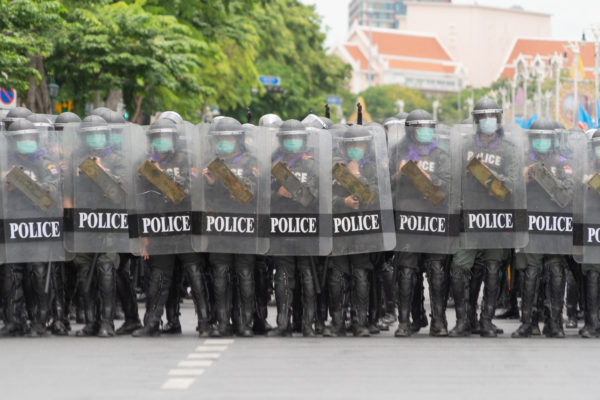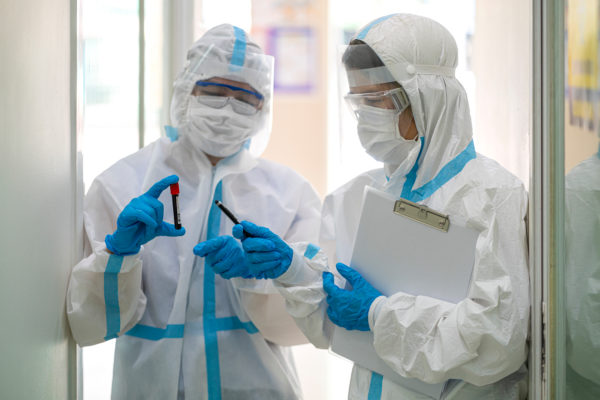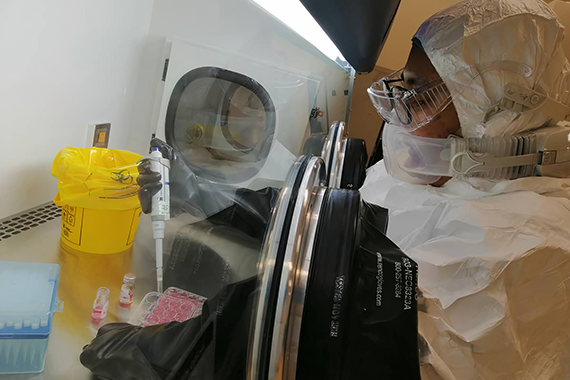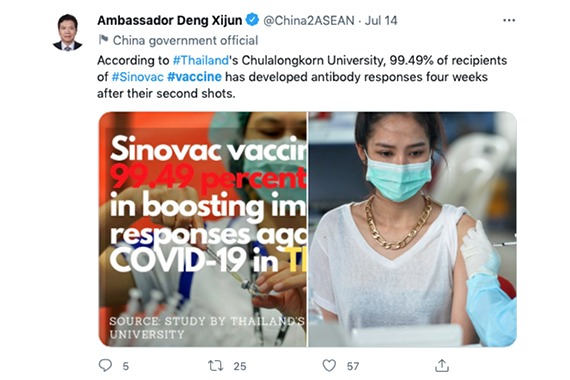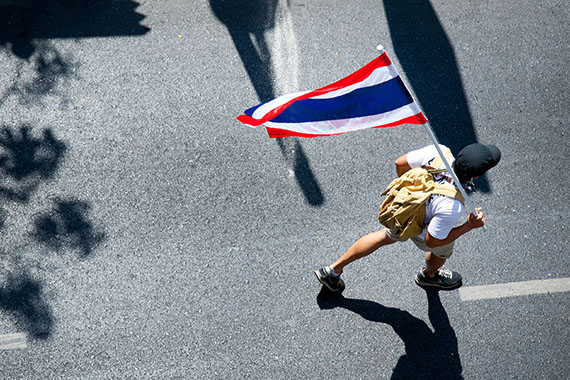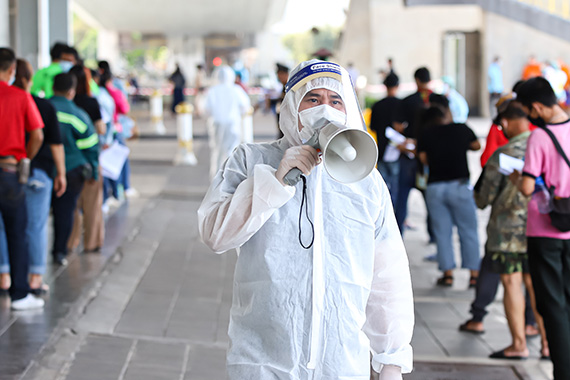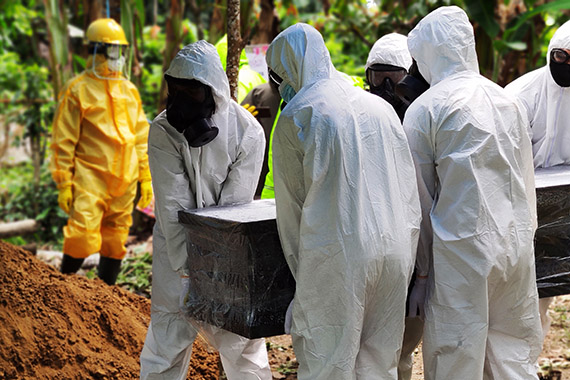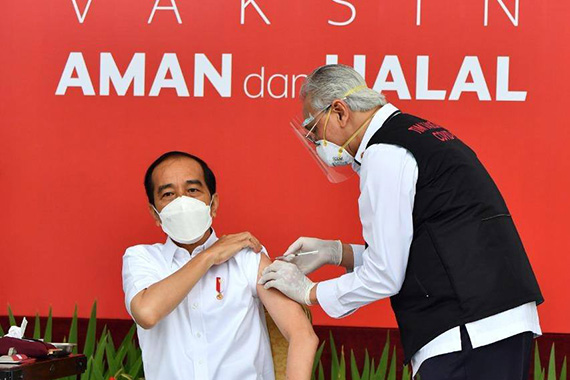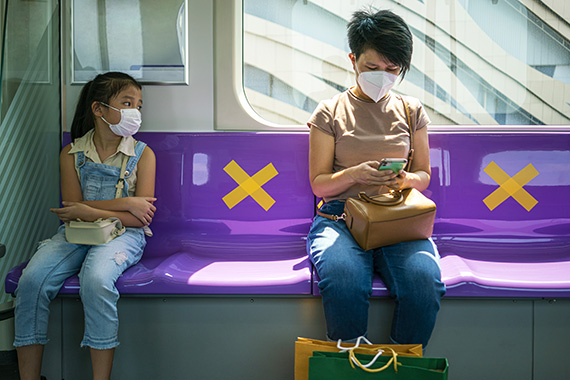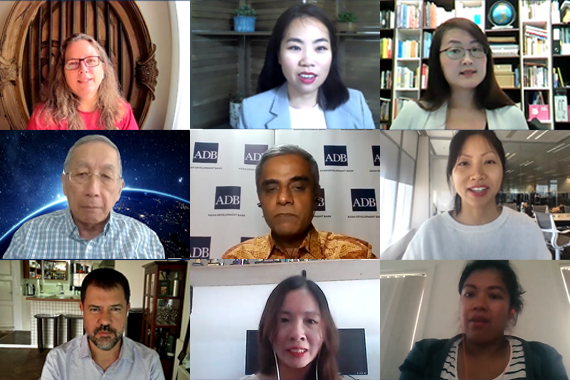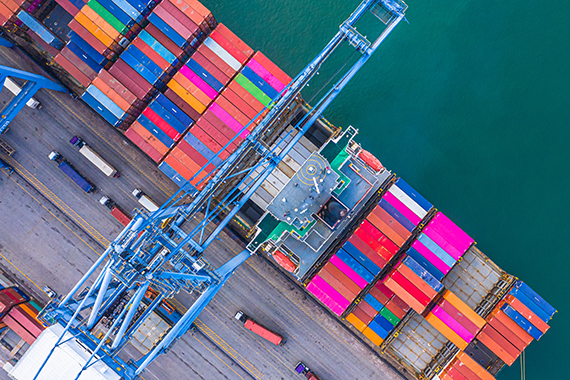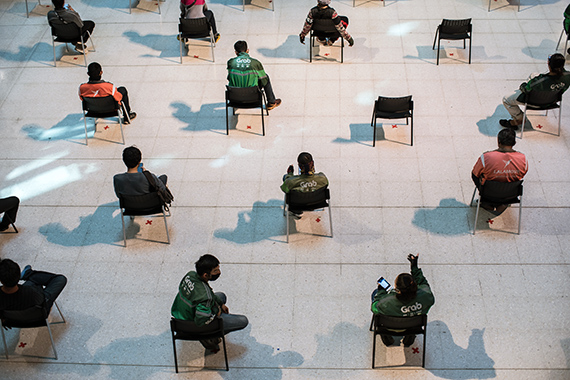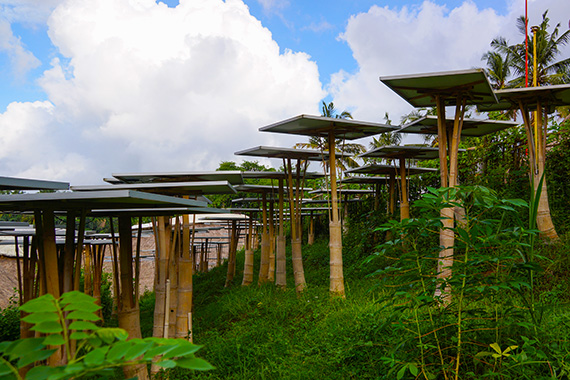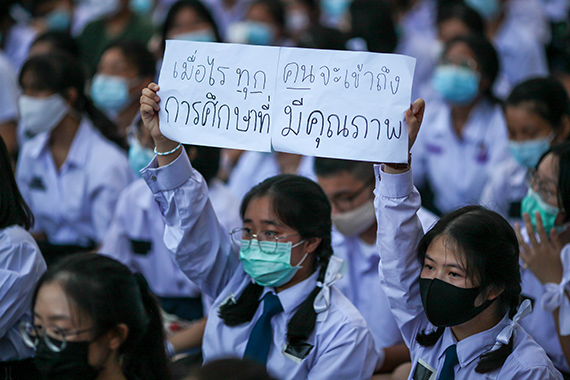Dealing With The Pandemic: Lessons Learnt And The Way Forward
By Dr Tikki Pang
Published on 12th October 2020
Read in 9 minutes
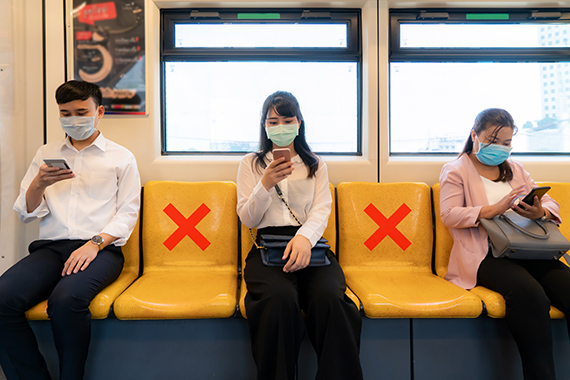
Bangkok MRT social distancing – Shutterstock
Amidst the carnage wreaked upon many countries in the developed world by the COVID-19 pandemic, some countries in Southeast Asia have shown impressive results in managing and controlling the pandemic.
While the United States, India, Russia and parts of South America and Europe struggle with the majority of global cases and fatalities, Singapore, Thailand, Vietnam and Cambodia, for example, have performed well. Beyond Southeast Asia, South Korea, Japan and Taiwan have also been examples of success.
Of the total number of more than 37 million reported cases and more than 1 million deaths globally at the time of writing, Southeast Asia recorded approximately 779,500 cases and 19,100 deaths, which represents 2.1 per cent and 1.9 per cent of global confirmed cases and deaths respectively [1].
Southeast Asian countries [2] also have a significantly lower case fatality rate, averaging 29 deaths/million population compared to a rate of 637 deaths/million population in the six OECD countries with the highest number of deaths [3]. At the same time, it should also be pointed out that some Southeast Asian countries, like Indonesia and the Philippines, continue to struggle to control the pandemic.
Skip to section:
What lessons have we learnt? What happens now? What about the importance of global solidarity? Interview About the AuthorWhat lessons have we learnt?
A number of factors are common to successful public health strategies in Southeast Asia.
First, speed of reaction and anticipation based on some key strategies: extensive testing, isolation and quarantine; diligent contact tracing; treatment of severe cases; social distancing and the banning of large gatherings (sporting events, religious gatherings, music concerts, etc); movement and travel restrictions (‘lockdowns’); and, the use of protective masks.
Second, and most importantly, was political will and commitment on the part of governments. Successful countries have demonstrated strong, firm, decisive, cohesive and evidence-based government action and directives that have been largely free from political interference.
Third, the above factors are supported by a system of good governance characterised by unity of action, common purpose and coordination at all levels (national, provincial and local). In Singapore, for example, a Multi-Agency Task Force co-chaired by the ministers of health and national development acted as an integrated, single focal point for the country’s responses to the pandemic. The Task force operated with a high level of transparency and accountability, with frequent and detailed communications to the public on the situation.
Fourth, success was due to populations that trusted the government, were cooperative and compliant to directives and, importantly, placed the safety of the community above other individual interests. Some have argued that a sense of social responsibility is stronger in Asian societies compared to the developed countries of the West, where a higher priority is placed on the rights of individuals and freedom of choice.
Fifth, these successful countries have been well prepared and quick to implement their decisions. They provided the necessary infrastructure for the use of digital health strategies in mitigating the effects of the pandemic, including big data analytics, artificial intelligence and mathematical modelling.
These digital technologies and platforms have been applied effectively in surveillance and monitoring of cases where, for example, data is integrated between departments of health and immigration. It has also been invaluable in contact tracing and even for fair distribution of medical equipment such as protective masks.
There may be additional factors which help explain low numbers in Myanmar, Laos and Cambodia, countries which have relatively weak health systems but have so far escaped the worst of the pandemic. These additional factors could include: lower population densities; more people living in rural areas; relatively younger populations who are less likely to transmit the virus combined with a lower proportion of elderly people; time lag (the virus simply hasn’t arrived!); cultural practices such as traditional greetings which avoid close bodily contact; fewer nursing homes for the elderly; genetic factors; and, people spending more time outdoors rather than indoors. There are no definitive answers, but it is likely that a combination of these factors are at work in these countries. And, of course, no country is pandemic-proof, as the new outbreak in Myanmar shows.
In contrast, countries which have been less successful in managing the pandemic have shown weak links in implementing some of the above strategies.
Indonesia, for example, has had difficulty in accessing sufficient diagnostic tests, has a population which has been less than compliant and cooperative in observing social distancing measures, and suffers from poor coordination between the central and provincial governments.
The Philippines was slow to react to the potential magnitude of the pandemic and in imposing strict restrictions and, later, lifted restrictions prematurely. It also suffered from testing gaffes and failures in quarantine protocols for the more than 100,000 overseas workers arriving back home after losing their jobs in other countries.
What happens now?
Based on what we know now, and the general opinion of scientists and public health experts, it is likely that the SARS-CoV2 virus will not disappear completely. Rather, it will become endemic in most, if not all, affected countries.
The ‘new normal’ will most likely see localised clusters of outbreaks during the second (or third) waves of the pandemic, as has been seen recently in Vietnam, Singapore, Malaysia and Myanmar.
Such clusters are linked to both local transmission as well as imported cases. As such, countries will need to adapt and learn to live with the virus and sustain those policies and strategies which have proven successful during the first wave of the pandemic. Six priorities are particularly important.
First, governments must continue to be willing to make tough policy choices to protect public health, including re-instating restrictions if needed. Though these restrictions are likely to be targeted and localised, rather than country-wide, they may still face resistance and protest from the population. As Alfred Einstein once observed “what is popular is not always right, and what is right is not always popular”.
Second, closely related to the above, there is an important need to sustain and enhance a sense of social discipline and responsibility in the community. This can be achieved through a mix of carrots and sticks: education and communication strategies and strict enforcement of restrictions, including punitive measures if necessary.
Third, the ability to detect and respond to clusters of outbreaks is critically dependent on effective, real-time and robust surveillance and monitoring systems for early detection of potential ‘hot spots’ and rapid institution of public health measures before widespread dissemination of the virus occurs among the general population.
In addition to the digital tools mentioned above, the value of a grassroots approach, where communities, and even neighbourhoods, play a sentinel role in early detection of potential cases, should not be underestimated. As Guenael Rodier, the former director of World Health Organization’s (WHO) department of Country Health Emergency Preparedness and International Health Regulations, says: “the best way to prevent the global spread of diseases is to detect and contain them while they are still local”.
Fourth, at the same time, there is a constant and critical need to ensure protection of front-line health workers who are dealing with symptomatic cases of COVID-19. Tragically, many of these front-line health workers have died in Indonesia and the Philippines during the pandemic as a result of shortages of personal protective equipment.
Fifth, countries must ensure that robust health systems are in place so that non-COVID-19 risks to public health can be managed. Several Southeast Asian countries – Indonesia, Thailand and Singapore, for example – have seen a surge in cases of dengue fever. The WHO has also warned of a dangerous drop in childhood vaccination rates as countries’ health resources are diverted to fighting the pandemic.
Sixth, countries must manage and control what scientists believe were the ultimate origins of SARS-CoV-2 and other pathogenic viruses: wildlife markets which freely exist not only in China but in many countries in Southeast Asia, including Indonesia and Thailand. It has been estimated that more than 60 per cent of pathogens [4] that have caused global epidemics of human disease have zoonotic origins, with bats, primates and rodents being the most prominent sources.
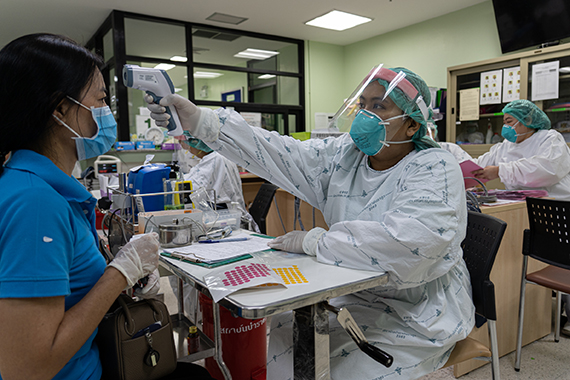
Frontline Health Workers Bangkok – UN Women Pathumporn Thongking – Flickr
While we can speculate on the future path of the pandemic, there is still much we do not know about the biology of the virus and, therefore, the future trajectory and dynamics of the pandemic. At the same time, countries all over the world have learnt valuable lessons during the past eight months and, arguably, are better prepared to deal with future crises.
There is also much we do know now. Unlike the situation at the onset of the pandemic, there have been significant advances in understanding the epidemiology of the disease – for example, the important role of asymptomatic carriers in spreading the virus.
Progress has also been made in identifying useful therapeutic interventions for severe cases of COVID-19 (these include Remdesivir, dexamethasone, antibodies from recovered patients and monoclonal antibodies).
Importantly, intensive research and development activities have been continuing in the development of vaccines against SARS-CoV-2 using various approaches. Advanced clinical trials are already underway with some candidate vaccines. However, at this point, we have no assurance as to when a safe and effective vaccine will be available, and how to ensure its efficient and equitable distribution.
What about the importance of global solidarity?
Countries in Southeast Asia that have successfully contained the pandemic have shown global and regional solidarity based on their adherence and compliance to international agreements such as the International Health Regulations developed by the WHO.
This has facilitated collective action based on trust and sharing of data, knowledge and experiences as countries in the region have realised their interdependence as a result of extensive trade, migrant workers and leisure travel across national borders.
External partners have also been prominent in the Global Health Security Agenda (GHSA) and, more recently, the Act Accelerator initiatives. The GHSA, an initiative led by the United States under the Obama administration, has close partnerships with many Southeast Asian countries to help them better prepare for, and respond to, infectious disease pandemics.
The well-funded Act Accelerator initiative, led by the WHO and the World Bank, has multiple partners committed to the accelerated development of vaccines, diagnostics and therapeutics against COVID-19.
Closer to the Southeast Asia region, Australia’s COVID-19 Development Response, led by its Department of Foreign Affairs and Trade, focuses on the Indo-Pacific region, particularly the Pacific, Timor-Leste and Southeast Asia. Its objective is to partner with the Indo-Pacific in responding to and recovering from COVID-19, in support of the region’s, and Australia’s, security and economic recovery.
Beyond the shores of Southeast Asia, and as eloquently expressed by former senior Singapore government official Kishore Mahbubani: “coronavirus is telling us to be a citizen of our country, and our world. The disease has shaken the human species to the core, but we must grasp the metaphysical messages it is sending. To survive in the short term, we need national solidarity – but to survive in the long term, we need global solidarity”.
Rather than the pandemic portending the end of globalisation, as some have suggested, it has starkly illustrated the interdependence between nations and the need for future solidarity based on trust and collective action to save humanity.
[1] Implicit in statistical data is the possibility of under-reporting confirmed cases and deaths in some developing countries due to limited testing and laboratory capacity, and differences between countries in case definitions and reporting accuracy and efficiency.
[2] Indonesia, Malaysia, Singapore, Philippines, Brunei, Thailand, Vietnam, Cambodia, Laos, Myanmar
[3] US, Mexico, UK, Italy, Spain, France
[4] Bacteria, viruses, fungi and parasites.
Interview
About the Author
Dr Tikki Pang is a global health scholar and visiting professor in the Yong Loo Lin School of Medicine at the National University of Singapore. He has previously held senior positions at the Lee Kuan Yew School of Public Policy at National University of Singapore, the World Health Organization and the University of Malaya.
